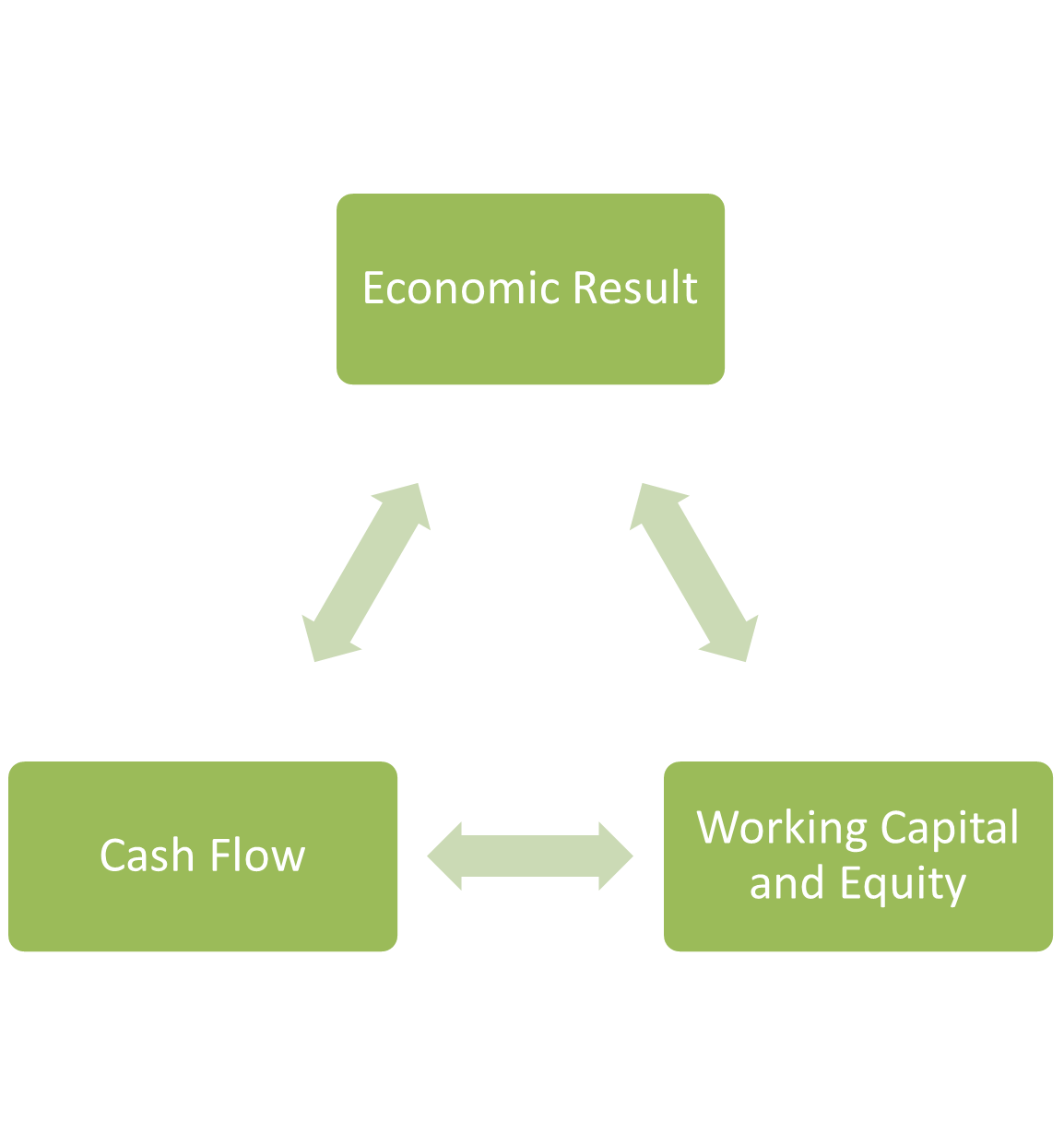The strategic management of the company also includes the management of the financial side of the business. It is not just about tracking the income statement, which shows the expected revenues and costs. Few entrepreneurs effectively monitor other aspects of the company’s long-term financial health. Economic stability is also about when revenues will actually be collected and expenses paid, and what share of own and external resources is suitable for achieving economic efficiency.
🎓 CAFLOU® cash flow academy is brought to you by CAFLOU® - 100% digital cash flow software
Company financial management triangle
At PADIA Ltd, we focus on the methodical setting of the company’s financial management. At our training sessions on company economy and as part of the consulting for setting up effective financial management, we emphasize that your successful company can be even more successful if you know where you are going.
However, three different aspects can be considered economic success:
- growth of the company’s wealth
- positive economic result
- positive cash flow
The economic success of companies can be measured by the growth in the value of the company and its wealth. However, success for entrepreneurs also means the company’s ability to generate money in order to ensure not only short-term solvency of the company, but also long-term prosperity and financial stability. Bookkeeping looks at the economic success or failure of companies primarily from the perspective of profit or loss. These three interconnected views of the company’s economy can be schematically expressed by a triangle of financial management.
 Economic Profit represents a difference of revenues and costs
Economic Profit represents a difference of revenues and costs
Cash Flow stands for a difference of income and expenses
Equity means a company’s wealth in the accountancy point of view
Wealth (Equity) = Property (Assets) – Debts (Other Sources than Equity)
Working Capital comprises of a value of inventories of materials, work in progress, finished products and goods, receivables and money in an account or he treasury
What economic goal do you pursue?
Are you clear about what the real priority of your business is? Subsidiaries are often evaluated on the basis of their profits. If the company in the group is in the black, it is possible to pay a dividend to the parent company. Economic results are then the main attribute of the reported information about the company. If the subsidiary ceases to prosper, the parent company may dispose of it through sale. After all, the market for mergers and acquisitions is very rich.
Another situation is a company pampered by the owner for many years, with the main goal being long-term stability; no sale of the company to others is considered at all. The priority is not the greatest possible profits, but the balance between own and external resources. Stable companies are able to withstand a possible future turn in the direction of the economy. If you are going to further develop the company, such as expanding the production portfolio, production capacities and equipment, warehouse space, or fleet, the priority will probably be cash flow.
What should be managed then
Effective financial management is devoted to all processes affecting the company’s economic results. It should reflect both the process of creating the economic result and cash flow and the long-term aspect of the company’s competitiveness, which represents a balanced size of working capital together with an appropriate level of external financing that can be monitored by the share of equity in total resources. Negative equity is a signal of the company’s over-indebtedness.
Despite many of the above economic concepts, financial management is primarily a matter for the company’s non-financial managers, not just company’s economists. Financial management is not just about ensuring a functioning accounting system and creating reports. Its aim is also to determine the financial strategy and to introduce financial management tools, to effectively connect financial resources with investments, with the development of market opportunities, salary development, etc., i.e. the general management of the company’s market value.
Not all cash flows are the same
Cash flow is a natural part of financial management of successful companies. The total cash flow must be analysed very carefully and quick conclusions avoided. If the total cash flow is great, it may be a sign of the company’s ability to produce some extra money. But it could also be a negative signal indicating that the company has not invested in new assets and new technology to prepare for future productivity. Even worse, this could be due to the fact that the firm has sold some key assets, which could put it at a competitive disadvantage in the future, or that the firm has greatly increased its long-term debt, which causes its financial structure to deteriorate and thus adds high financial risk to potentially high business risk, which could cause very serious problems in the near future.
On the other hand, if the total cash flow is very low or even negative, it could probably be a negative signal indicating the company’s inability to produce funds. But it could just as well mean that the company is making tremendous investment efforts, rebuilding assets, redirecting its operations to more profitable market segments, or significantly improving its financial structure by repaying high long-term debts and thus preparing for a better financial future.
The diagnosis at the level of operating cash flow is much easier. The higher it is, the better it is, and the greater freedom and flexibility it gives the company to build its long-term strategy without restriction and interference from (external) financial resources.
<< Back to all articles in Caflou cash flow academy
Article author: Pavlina Vancurova, Ph.D. from ![]()

In cooperation with Pavlina Vancurova, Ph.D., specialist in business economics from consulting firm PADIA, we have prepared the Caflou cash flow academy for you, the aim of which is to help you expand your knowledge in the field of cash flow management in small and medium-sized companies.
In her practice, Pavlina provides economic advice in the area of financial management and setting up controlling in companies of various fields and sizes. In 2011, she co-founded the consulting company PADIA, where she works as a trainer and interim financial director for a number of clients. She also draws on her experience as the executive director of an international consulting firm. She worked as a university teacher and is the author of a number of professional publications.